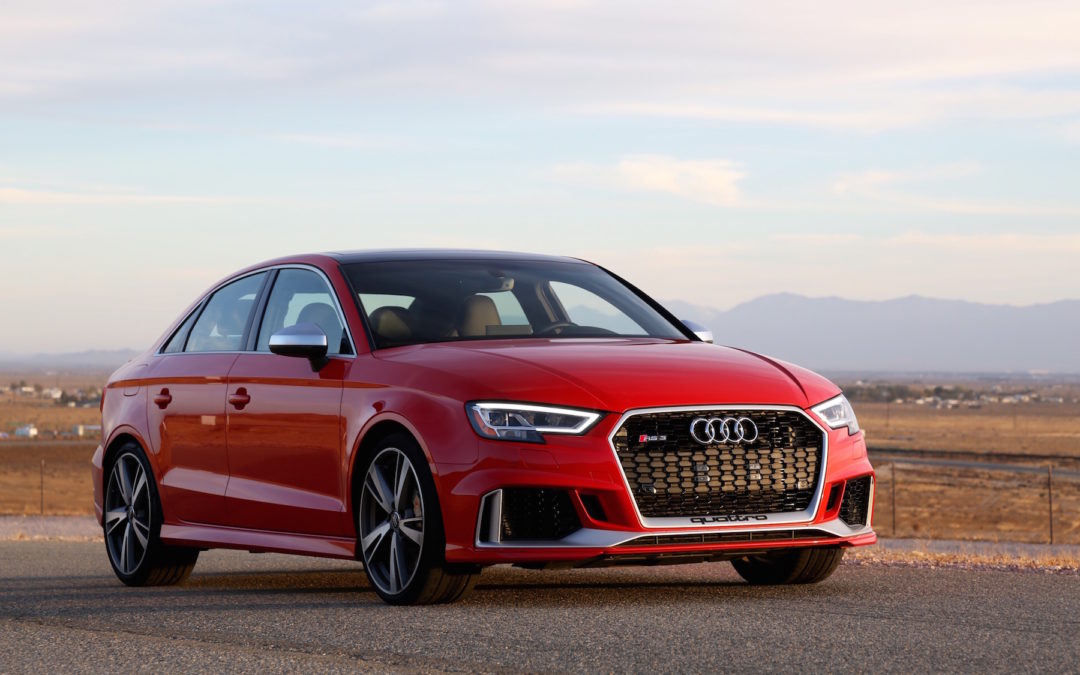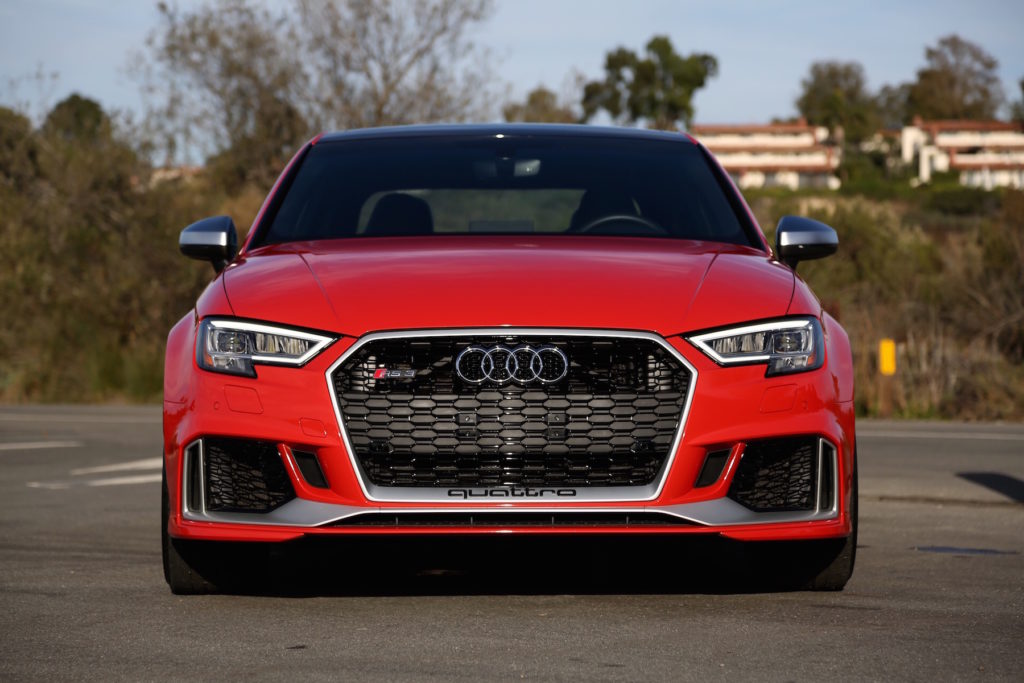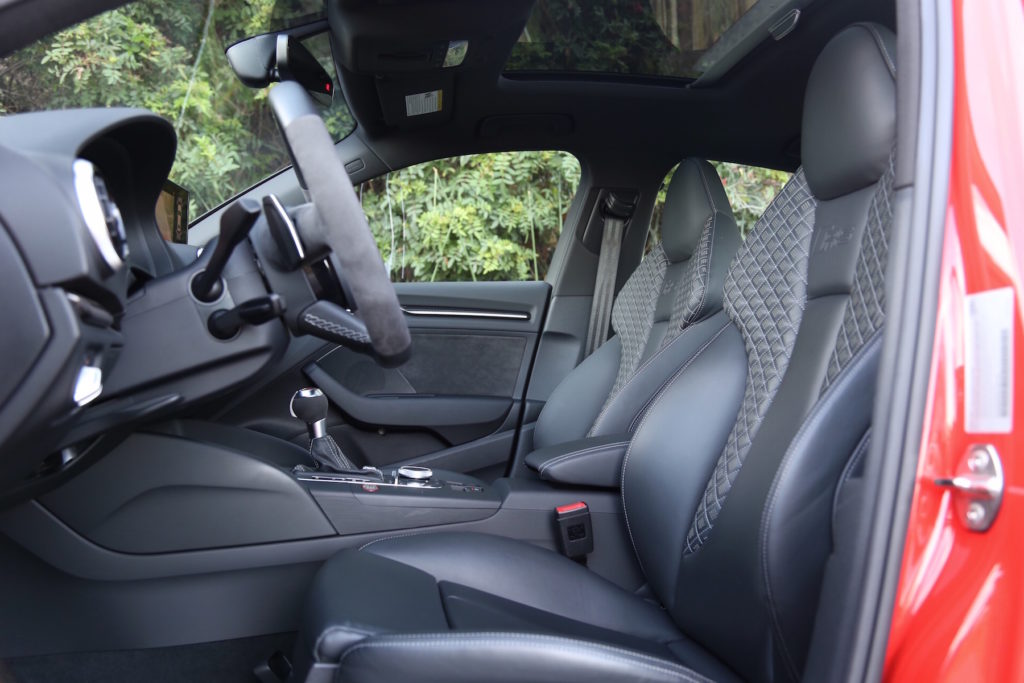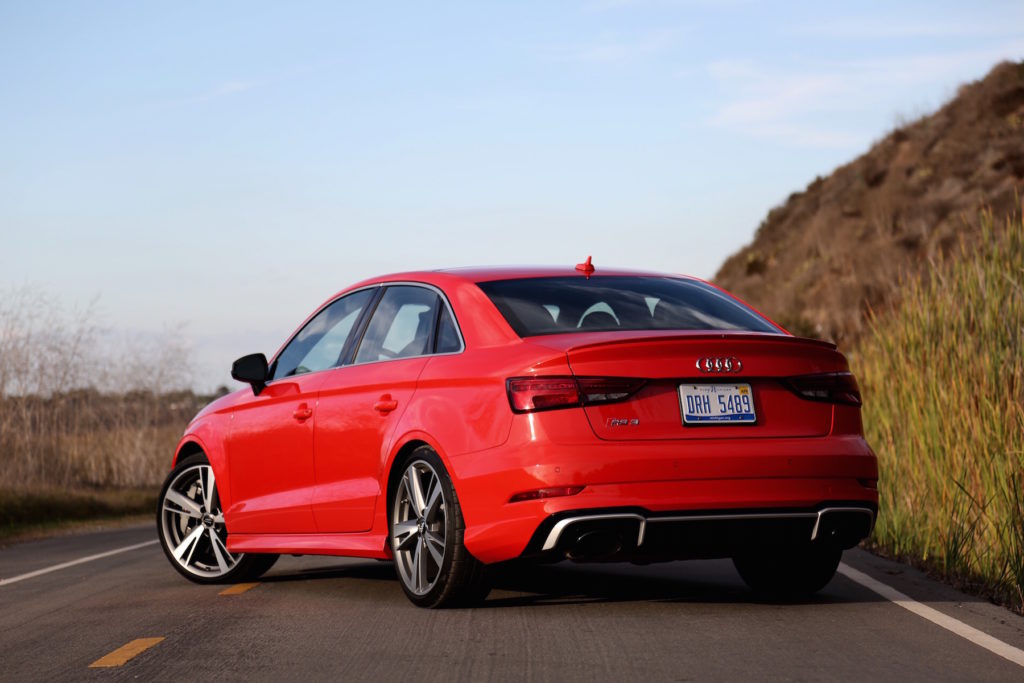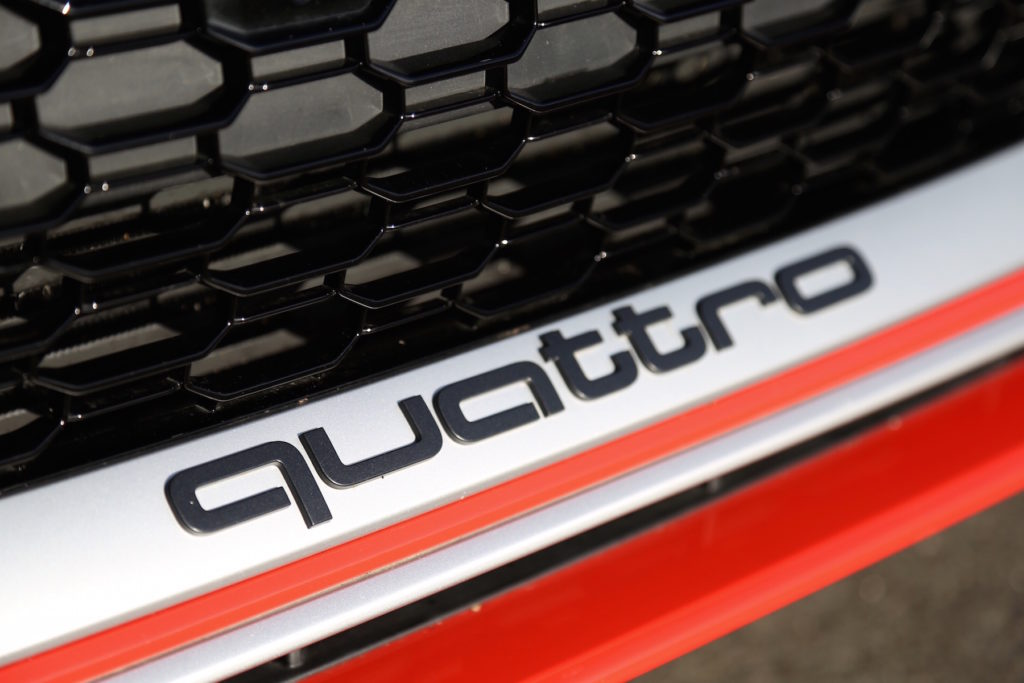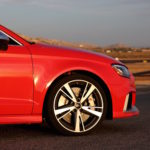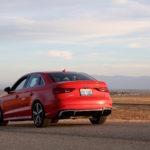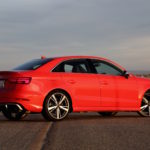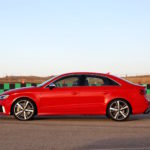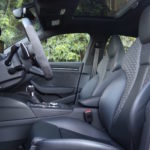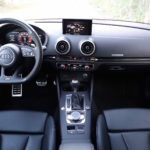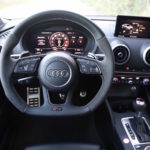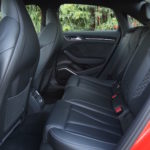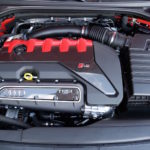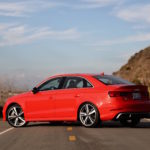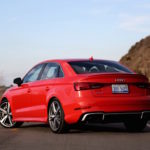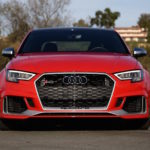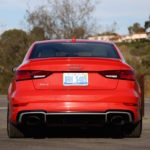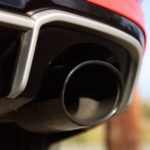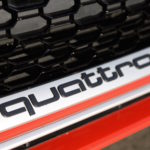Cramming absurd amounts of power into compact automobiles is an art form. Thanks to Volkswagen’s pioneering work with the Golf GTI, the hatchback body style is the most common vessel for these engineering experiments. Something about the blend of utility and performance gets the modern car enthusiast all riled up.
Though hot hatch love is universal, Americans have historically been overlooked by European and Japanese automakers. When jealousy got the better of us, we’d find the nearest V8 muscle car and rip a burnout; alas, it was only a short-term solution. Then, what felt overnight, manufacturers began shipping their automotive untouchables to the U.S. In came Ford’s Focus RS, Honda’s Civic Type R, and Audi’s RS3 – just as they appeared overseas…well, almost.
The five-door hatchbacks exceeded even our most inflated expectations, but Audi’s insistence on a sedan-bodied RS3 rubbed us the wrong way. At first we scoffed, but then we got a look at its spec sheet. “400 horsepower, you say? Might as well take it for a spin before passing judgment.” To conduct a fair trial, we took the baby RS on roadways and raceways – at sea level, and 2,500 feet above it. Now it’s time to read the verdict: here’s our 2018 Audi RS3 Review.
New for 2018
Abroad, Audi has sold two generations of its RS3, both with an inline five-cylinder engine made from cast-iron. 2017 was both the first model year for the U.S. market RS3 and the first application of Audi’s aluminum block five-cylinder (shared with the TT-RS). 2018 model year RS3 models now receive blind spot monitoring and rear cross-traffic alert as standard, but all other changes from 2017 take the form of optional packages.
Styling
As both the entry point for Audi’s most pumped-up performance cars and the A3 model line’s uppermost designation, the RS3 is styled for impact. At the front, the RS3’s wider track (compared to A3/S3 versions) features larger air intakes with platinum slats to match current RS vehicles. Standard LED headlights and daytime running lights assure eye-searing goodness after dark, while a prominent “Quattro” badge at the base of the honeycombed grille points to the car’s all-wheel drive setup.
In profile, standard 19-inch five-arm blade wheels can be finished in silver, titanium, or with black accents. Choose the Black Optic Package ($1300) to add black housings for the mirror caps, a black grille surround, and a black rear lip spoiler. At the rear, a platinum trim piece outlines the diffuser and a pair of large oval exhausts. As we’ve come to expect from Audi RS products, the overall look is sharp and imposing without crossing into garish territory.
Price
At its $55,900 starting point ($400 more than last year), the 2018 Audi RS3 is loaded with standard features like a panoramic sunroof, keyless entry and ignition, a backup camera, front and rear parking sensors, heated front seats, heated, auto-dimming mirrors, dual-zone automatic climate control, HD Radio, Apple CarPlay, Android Auto, Bluetooth, HD Radio, and dual USB ports. Audi also offers a number of packages to nudge the RS3 higher in the luxury hierarchy.
Technology
Audi’s all-new A8 and A7 are pushing the boundaries for driver safety and convenience technologies, but even the lowly A3 packs a number of gadgets. Beyond the standard goodies listed above, Audi offers a Technology Package ($3,200) that includes MMI Navigation and MMI Touch, Audi Connect apps, Audi’s Virtual Cockpit digital display, and a 14-speaker Bang & Olufsen sound system.
Only in the TT and R8 will you find Audi’s now-familiar 12.3-inch digital driver display as standard, but the price of admission soon becomes an afterthought the more you interact with this superb interface. Abundant telemetry, mapping, and multimedia data are accessible via an intuitive, customizable, and vivid display. Since Virtual Cockpit made its debut three years ago, several automakers have introduced their own digital dashboards, but none feel as seamless as Audi’s effort.
Whether you prefer a digital or analog cockpit, a standard 7.0-inch monitor is perched on the dashboard. Unlike the tacked-on screens in certain Mercedes-Benz, products, however, you can slip the display into the dash at the press of a button. Drivers can operate Audi’s MMI infotainment system via steering wheel-mounted buttons, voice commands, or the MMI Touch controller (if equipped).
Interior
Inside, Audi makes an effort to spruce up the entry-level A3’s cabin, but there’s only so much that can be done to make a $30K car feel worthy of its near-$60K price tag. A set of quilted leather sport seats, micro-fiber suede inserts in the steering wheel, on the shift lever, and within the door panels, and optional carbon fiber inserts are chief among the RS3’s stylistic upgrades.
Without any package add-ons, the RS3 is more affordable, but its cabin is largely frill-less. Enhanced with the digital instrument cluster, the B&O sound system, and the $1,000 RS Design pack’s red accents, the RS3 assumes the role of a premium product – notwithstanding some budget shift paddles and a hard-paneled dashboard.
Look beyond the cabin layout and the RS3 experience improves significantly. Worthy of note is the little sedan’s supple ride quality and comfortable seats, which are on par with any luxury vehicle. Audi’s magnetic ride dampers can stiffen for flatter cornering, but they can also soften for smoother commuting. Even with the optional fixed suspension, the RS3 stops short of a punishing ride — evening out the harshest bumps before they hit rider rumps. Similarly, the sport bucket seats may look aggressive, but in fact afford daily driving comfort and effective bolstering during high-G maneuvers.
Interior volume is another tally in the RS3’s ‘pro’ column. Despite its subcompact size, the RS3’s tall-ish roofline means ample headroom to go with surprisingly good rear legroom. At 10.0 cubic feet, the RS3’s trunk isn’t massive, but with split-folding rear seats, there’s still some versatility at your disposal.
Driving Dynamics
Perhaps Audi held off on bringing the RS3 stateside because it (correctly) assumed we would judge such a diminutive model for wearing a celebrated badge. With imposing RS Sport creations like the RS5, RS7, and TT-RS percolating in our minds, where does a subcompact sedan fit in?
According to the facts and figures, right in the thick of things. Under the hood you’ll find a 2.5-liter turbocharged inline five-cylinder with 400 horsepower and 354 pound-feet of torque on tap. Power is delivered to all four wheels (each shod in Pirelli P Zero rubber) via a seven-speed S-Tronic dual-clutch automatic transmission. With this much grunt and a sophisticated launch control system at the ready, the 3,500-pound RS3 bolts to 60 mph in just 3.5 seconds. Opt for the Dynamic Plus package ($4,800) and the car will top out at 174 mph.
To put these numbers into perspective, the 465-hp Corvette Grand Sport takes 3.9 seconds to hit 60 mph and Audi’s own 540-hp R8 V10 will only match the RS3’s acceleration. Up to snuff; we think so. When not engaged in stoplight exhibitions, the RS3’s wide torque curve of 1,700 – 5,850 rpm means usable thrust during everyday commuting. We’ll admit there’s a bit of a delay when conjuring boost, but the five-cylinder’s smoothness more than makes up for any lag. It’s also a reasonably efficient motor (especially given the output). Around town, the RS3 only manages 19-mpg, but on the highway you’ll see 28 mpg.
What catches us most by surprise, though, is the RS3’s body control. Around town, the car feels tight and precise, but only when faced with a racetrack does the RS engineering truly shine. Thanks to NASA Pro Racing’s SoCal division, we have a chance to match the feisty four-door with perhaps the perfect road course. The Streets of Willow packs 14 corners into a 1.6-mile circuit, promising plenty of lateral exercise. Even with a relatively short 1,000-foot-long straightaway, excellent brakes and balanced handling are a must. Thankfully, our test car features the optional Carbon Ceramic front brakes and a fixed RS-tuned suspension (as part of the Dynamic Plus package).
With the transmission and stability control in Sport, the turbocharger is always spooled and the computers are less invasive. Though the car has a nature weight imbalance of 57:43 front-to-rear, reverse staggered tires (255-section in front and 235-section in the rear) let the rear end rotate while planting the front end. Audis have a bad rap for understeering at the limit, but RS Sport has tuned the plough clean out of the RS3. Negotiating a corner at speed, the RS3 adheres the front and wiggles the rear, effectively turning the car more quickly. Aided by a torque vectoring system, the Haldex all-wheel drive prefers to issue power through the front tires, but won’t hesitate to send full thrust to the rear. The result of all this is front-drive sensation without any of the drawbacks.
Corner after corner, the RS3 stays flat and neutral, allowing for mid-corner adjustments via the throttle, brake, and steering that would otherwise be impossible. Steering is light – even in Dynamic mode – but precise in a way that only improves the driving experience. How about ‘dem brakes, though? In the video above, I jokingly compare them to a good friend who keeps you out of trouble, but the message is sincere: these carbon ceramic wonders (combined with the sticky Pirellis) are the difference between good and exceptional on-track performance. Even after a full day of lapping, the RS3 maintains immense braking bite and responds well to trail-brake articulation.
Safety
Though the 2018 Audi RS3 has not specifically been rated by either the IIHS or NHTSA, the 2018 Audi A3 earns a Top Safety Pick Plus rating from the IIHS and a five-star rating from the NHTSA. Standard safety features on the RS3 include driver and passenger front-facing airbags, knee airbags, front thorax side airbags, Sideguard® head curtain airbags, ABS, ESC, LATCH restraints for the rear seats, Audi Pre Sense Basic (pre-collision safety), a backup camera, parking sensors, blind spot monitoring, and rear cross traffic alerts.
The optional driver assistance package ($1,400) adds adaptive cruise control with stop & go, lane keeping assist, automatic high beams, and a front facing radar system with distance control.
Our Perfect RS3
For most performance cars, we like to keep the options at a minimum, but in the case of the RS3’s somewhat underwhelming cabin, we’d add a few things. First would be the Dynamic Package ($1,450), which adds reverse staggered performance tires, 19-inch Titanium wheels, and RS sports exhaust with black tips. On top of that, the Dynamic Plus Package ($4,800) includes our much-loved carbon ceramic brakes, RS suspension, and a carbon fiber engine cover. Our final add-on would be the Technology Package ($3,200) with its Virtual Cockpit display, B&O sound system, and MMI Navigation upgrades. To save a bit of money, we’d forgo our tester’s sizzlin’ Catalunya Red paint job in favor of the Nardo Gray exterior. All told, our perfect 2018 Audi RS3 is $64,350 (plus $975 in destination and handling fees).
Competition
Audi’s RS3 most closely competes with BMW’s M2 and Mercedes-AMG’s CLA45. Among these, the RS3 is quickest to 60 mph, the most powerful, and offers the most voluminous cabin; it’s also priciest. We have no doubt the RS3 will lap a given circuit quicker than both its rivals, but the M2 — with its rear-drive setup and available manual transmission — takes a slight edge in the all-important fun-to-flog category. Daily drivability, versatility, and convenience (especially provided a few options) favor the RS3. With the CLA45 lagging far behind, the choice between M2 and RS3 comes down to driving style. If you want to hang tail and don’t need the extra set of doors, go with the M2. Otherwise, the RS3 is your best bet.
The Verdict
Genuine surprises are rare, but when one comes along, it’s worth savoring. As it turns out, Audi and its in-house tuning family built something far greater than the RS3’s numbers suggest. Even as hard as the RS3 launches, straight-line thrills can get old – stellar driving dynamics do not. Who’s to say whether we’d have loved prior generations of the super subcompact as much as we do this one, but the car Audi has finally given America is an unmitigated triumph. In fact, this may be our favorite RS yet.

